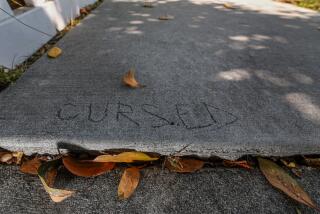Traffic-Choked N. Redondo Looks for Solutions, Finds Them Painful
- Share via
The morning sunshine, the brisk salt air, the twittering of little birds--it used to be that when Dona Bauer thought “daybreak,” these simple pleasures would come to mind.
But that, she says, was “seven miserable months ago,” before she and her family moved to North Redondo Beach. Now dawn brings the roar of engines and the rumble of wheels, and her double-paned windows rattle with the beginning of another morning commute.
“It’s unbearable,” the 36-year-old lawyer says. “No one told me about this when we moved in. I’m tired. I’m haggard. I have a $451,000 home, and I can’t get to sleep in it.”
On the neighborhood lanes of North Redondo Beach, rude awakenings are a fact of life. Each year, residents say, their narrow streets, built for moms in station wagons and kids on training wheels, grow ever more congested with breadwinners short-cutting their way to work.
The situation has prompted a series of city-sponsored workshops and hearings aimed at finding a comprehensive solution. But many see it as just another chapter in what the city engineer calls the “lose-lose” dilemma of trying to control traffic in the booming South Bay.
“Just 25 years ago, North Redondo was quiet and peaceful. Now it’s a major commuter route,” says Larry Cote, a bus driver and chairman of the city’s North Redondo Traffic Committee. “Traffic starts coming as early as 5:30 a.m., rumbling up and down hills, disturbing the neighbors’ sleep, making it almost impossible to back out a driveway. Sometimes the traffic is still out there at 11 o’clock at night.”
Officials blame the problem on growth, geography and the history of Redondo Beach. The main thoroughfares that connect beach-city suburbanites and freeway drivers to the South Bay’s offices and industrial complexes have become so jammed, they say, that, for too many people, cutting through North Redondo’s neighborhoods has become the only way to get to work on time.
The layout of the city’s 40-year-old north side contributes to the problem, said Ken Montgomery, city engineer and director of public works.
Suburbs nowadays are shielded from “commuter infiltration” through the installation of cul de sacs, dead ends, walls and “collector” streets that efficiently funnel cars away from residential streets and onto main arterials. But North Redondo Beach, which was subdivided just after World War II, was laid out in a simple grid pattern to maximize the number of residential lots, Montgomery said.
“The concentration of major employers in the South Bay makes it an even worse problem,” he said. TRW in Redondo Beach, Xerox and Hughes in El Segundo and a host of other high-tech and manufacturing concerns draw employees from throughout the area and beyond. In addition, many employees of Los Angeles International Airport live there.
As main arterials such as Inglewood Avenue and Artesia, Manhattan Beach and Aviation boulevards become congested, motorists flee to side streets. A recent license-plate survey of commuters on North Redondo streets found that two-thirds of the cars were registered to people from other cities.
Built to carry 2,000 cars a day at most, the 28-foot-wide streets of North Redondo now carry up to 15,000 apiece, Montgomery said.
Meanwhile, residents of the second-generation housing that characterizes the area--yardless condominiums and narrow homes known as “tall and skinnies”--are getting more and more fed up.
“It’s a crisis situation,” said marketing executive Roberleigh Richester, 40, another member of the traffic committee.
“It’s very heavy traffic and very fast traffic, and there are children in this neighborhood who walk to school,” Richester said. “One woman told me she almost got hit twice in a row trying to cross the street. My sister’s cat got squashed.”
But solutions are elusive.
Efforts in the 1970s to widen the streets were struck down by voter initiative, Montgomery said. Later in the decade, a series of concrete diverters designed to detour short-cutters back to major thoroughfares was yanked out within a month amid public outcry.
Even the three solutions being offered by the North Redondo Traffic Committee have serious shortcomings, Cote and Richester admit. One would cut the length of green lights in residential areas to five seconds. Another would seal off neighborhoods with a maze of one-way streets. A third would send short-cutters in circles with a proliferation of right-turn-only signs that would lead them back onto main arterials.
These solutions look so painful that when they were discussed Tuesday night at the first of a series of neighborhood workshops, the audience suggested that the city scrap them all and stick to improving the major thoroughfares.
Richester isn’t sure what the reception will be at future workshops--there’s another coming up 9 a.m. Saturday at the Jefferson School cafeteria--but he expects old commuting habits to die hard.
“Ninety percent of the people at the meeting said we had to do something about it,” Richester said. “But almost every speaker who came up to the podium said, ‘We don’t like your alternatives.’ ”
The committee hopes to come up with a single proposal that the City Council can vote on next year.
And if the politicians are skeptical about the problem, Dona Bauer, who lives off Rindge Lane, one of the commuter shortcuts to TRW, has a standing offer.
“I invite every member of the City Council to spend the night at my house,” she said. “Let them try to get some sleep.”
More to Read
Sign up for Essential California
The most important California stories and recommendations in your inbox every morning.
You may occasionally receive promotional content from the Los Angeles Times.










